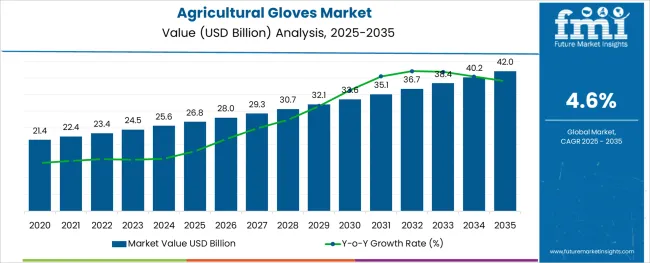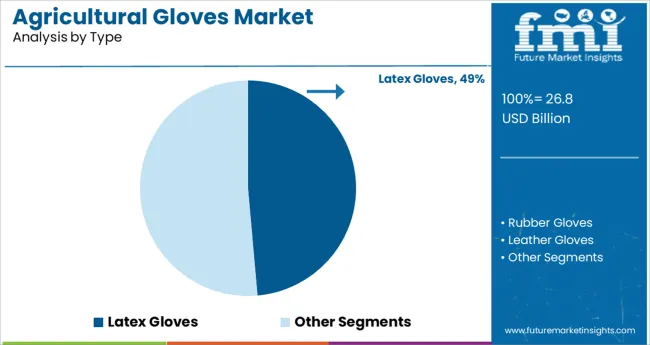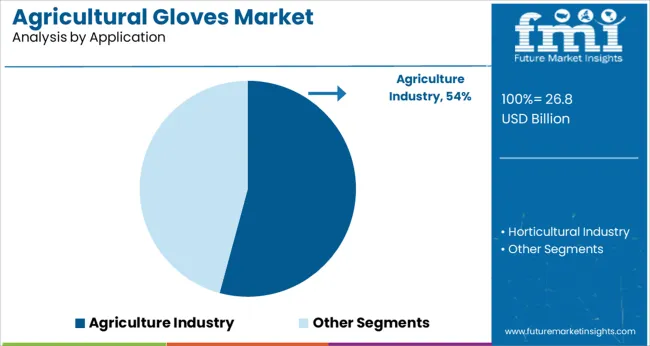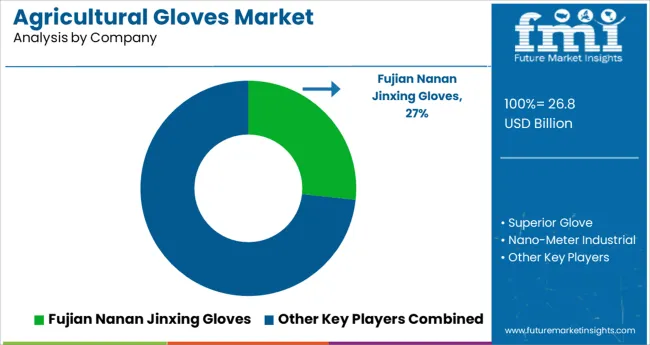The Agricultural Gloves Market is estimated to be valued at USD 26.8 billion in 2025 and is projected to reach USD 42.0 billion by 2035, registering a compound annual growth rate (CAGR) of 4.6% over the forecast period.

The agricultural gloves market is witnessing consistent growth fueled by the rising emphasis on worker safety, hygiene compliance, and durability in outdoor and industrial farming environments. Increased mechanization across agricultural practices has created a greater need for protective wear, especially hand protection that can withstand abrasions, chemical exposure, and varying weather conditions.
In parallel, rising health awareness among workers and employers alike is encouraging the adoption of certified protective gloves. Advances in glove materials, including biodegradable and chemical-resistant variants, are aligning with environmental regulations and farm safety protocols.
Moreover, government initiatives supporting personal protective equipment in agriculture, particularly in developing economies, are strengthening market adoption. The outlook remains positive, driven by growing concerns about injury prevention, ergonomic design innovations, and expanding use cases in livestock handling, crop harvesting, and greenhouse operations.
The market is segmented by Type and Application and region. By Type, the market is divided into Latex Gloves, Rubber Gloves, Leather Gloves, Cotton Gloves, and Others. In terms of Application, the market is classified into Agriculture Industry and Horticultural Industry. Regionally, the market is classified into North America, Latin America, Western Europe, Eastern Europe, Balkan & Baltic Countries, Russia & Belarus, Central Asia, East Asia, South Asia & Pacific, and the Middle East & Africa.

The latex gloves segment is projected to account for 48.60 percent of the total market share in 2025 within the type category, making it the leading sub-segment. This dominance is attributed to latex’s strong elasticity, close fitting comfort, and high dexterity, which are essential for tasks requiring precision such as planting and pruning.
Its natural resistance to tears and chemical penetration provides protection in pesticide application and soil handling. Additionally, the affordability and wide availability of latex gloves have supported their high usage across small and large agricultural operations.
The segment’s leadership is further reinforced by the growing shift toward biodegradable latex formulations that offer sustainability benefits while maintaining safety standards in daily fieldwork.

The agriculture industry sub segment is expected to capture 54.20% percent of total market revenue in 2025 under the application category, positioning it as the dominant area of use. This growth has been driven by increased adoption of protective gloves across farming, livestock management, and agrochemical handling.
The physical demands of agricultural labor, which involve extended exposure to soil contaminants, sharp tools, and heavy machinery, have intensified the demand for durable gloves. Additionally, policies mandating personal protective equipment in pesticide and herbicide applications are reinforcing glove use.
The segment's dominance is also supported by expanding organic and high value crop farming, where glove usage is essential for minimizing contamination. These factors together continue to propel the agriculture industry as the core application driver within the agricultural gloves market.
Agricultural gloves are made of different types of polymers in order to protect the hands of the farmers from chemicals and pesticides that are used in agricultural crops. An agriculturist needs to perform various kinds of work which requires protection of their hands.
Some of the regular works undertaken in an agriculture farm include distribution of chemicals and pesticides, pruning of branches, harvesting crops, horticulture which renders the farmer susceptible to various kinds of risks such as abrasion, sting, cold conditions and deep cuts. Agricultural gloves act as a protective piece of clothing from the various physical risks in agriculture such as thermal, mechanical and chemical hazards.
The agricultural gloves market is driven by the growth in agricultural arena across the world. Moreover the increasing awareness of health and safety coupled with specific requirement for the use of protective equipment during handling of certain toxic chemicals has been a major factor for the growth of the agricultural gloves market. Agricultural gloves are generally made of latex, rubber, leather or cotton depending upon the end uses.
Gloves of different materials and thickness are required for different applications. Latex gloves are used for general agricultural purpose and are usually disposable. Chemical resistant gloves are used by farmers during compilation and spraying of pesticides which are harmful for the human skin.
Often it is advised to wear two pairs of gloves while handling chemicals which might pose a biological hazard. The usage of agricultural gloves has increased over the years owing to the increasing safety standards and general awareness among the agricultural community in the western world.
Although the market has shown tremendous growth prospects, it is yet to reach optimum penetration in several emerging economies such as India and China, even though a huge population in these agro based economy depend of agriculture for their livelihood.
Access to quality gloves as well as awareness for safe procedures is non-existent in many rural areas of the small and impoverished countries. However these countries present an opportunity for the agricultural gloves market to grow.Low cost disposable agricultural gloves are expected to provide the best opportunity for the market in these regions.
North America accounts for the largest demand for agricultural gloves and the growing agricultural market augurs well for the agricultural gloves market in North America. Asia Pacific is the second largest market for agricultural gloves in the world. Asia Pacific is also the largest producer and exporter of agricultural gloves lead by China.
The market for agricultural gloves is expected to grow at the fastest pace in Asia Pacific as it poses the maximum potential for growth owing to high agricultural dependence and low penetration of the product.
The agricultural gloves market is highly fragmented with several regional players dominating the market in different regions especially in Asia Pacific. The low cost of setting up a plant, availability of cheap labor and access to the raw materials is the primary reason for the growth of the manufacturing units of agricultural gloves in China.
Some of the companies involved in the market include Fujian Nanan Jinxing Gloves Co., Ltd., Ansell Healthcare Europe, Nano Meter Industrial, and Superior Glove among many others.
This research report presents a comprehensive assessment of the market and contains thoughtful insights, facts, historical data and statistically-supported and industry-validated market data and projections with a suitable set of assumptions and methodology. It provides analysis and information by categories such as market segments, regions, product types and distribution channels .

The global agricultural gloves market is estimated to be valued at USD 26.8 billion in 2025.
It is projected to reach USD 42.0 billion by 2035.
The market is expected to grow at a 4.6% CAGR between 2025 and 2035.
The key product types are latex gloves, rubber gloves, leather gloves, cotton gloves and others.
agriculture industry segment is expected to dominate with a 54.2% industry share in 2025.






Full Research Suite comprises of:
Market outlook & trends analysis
Interviews & case studies
Strategic recommendations
Vendor profiles & capabilities analysis
5-year forecasts
8 regions and 60+ country-level data splits
Market segment data splits
12 months of continuous data updates
DELIVERED AS:
PDF EXCEL ONLINE
Agricultural Multifunction Grab Bucket Market Size and Share Forecast Outlook 2025 to 2035
Agricultural Bucket Market Size and Share Forecast Outlook 2025 to 2035
Agricultural Lighting Market Forecast and Outlook 2025 to 2035
Agricultural Sprayers Market Size and Share Forecast Outlook 2025 to 2035
Agricultural Fumigant Market Size and Share Forecast Outlook 2025 to 2035
Agricultural Coatings Market Size and Share Forecast Outlook 2025 to 2035
Agricultural Secondary Nutrients Market Size and Share Forecast Outlook 2025 to 2035
Agricultural Chelates Market Size and Share Forecast Outlook 2025 to 2035
Agricultural Tractors Market Analysis - Size, Share, and Forecast Outlook 2025 to 2035
Agricultural Tires Market Analysis - Size, Share, and Forecast Outlook 2025 to 2035
Agricultural Pheromones Market Size and Share Forecast Outlook 2025 to 2035
Agricultural Adjuvant Market - Size, Share, and Forecast Outlook 2025 to 2035
Agricultural Microbials Market Size and Share Forecast Outlook 2025 to 2035
Agricultural Activator Adjuvant Market Analysis - Size, Share, and Forecast Outlook 2025 to 2035
Agricultural Surfactants Market Analysis – Size, Share, and Forecast Outlook 2025 to 2035
Agricultural Testing Services Market Growth - Trends & Forecast 2025 to 2035
Agricultural Mapping Services Market Growth - Trends & Forecast 2025 to 2035
Agricultural Grade Zinc Chemicals Market Growth - Trends & Forecast 2025 to 2035
Agricultural Fabrics Market Growth - Trends & Forecast 2025 to 2035
Agricultural Food Grade Rubber Conveyor Belt Market Growth - Trends & Forecast 2025 to 2035

Thank you!
You will receive an email from our Business Development Manager. Please be sure to check your SPAM/JUNK folder too.
Chat With
MaRIA